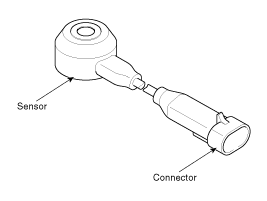 Kia Sedona: Knock Sensor (KS) Description and Operation
Kia Sedona: Knock Sensor (KS) Description and Operation
Third generation YP (2014-2025) / Kia Sedona YP Service Manual / Engine Control / Fuel System / Engine Control System / Knock Sensor (KS) Description and Operation
| Description |
Knocking is a phenomenon characterized by undesirable
vibration and noise that can cause engine damage. Two Knock Sensors (KS)
are installed inside the V-valley of the cylinder block to sense engine
knocking.
When knocking occurs, the vibration from the cylinder block is applied as pressure to the piezoelectric element.
When a knocking occurs, the sensor produces voltage signal.
The ECM retards the ignition timing when knocking occurs. If the
knocking disappears after retarding the ignition timing, the ECM will
advance the ignition timing. This sequential control can improve engine
power, torque and fuel economy.

 Knock Sensor (KS) Specifications
Knock Sensor (KS) Specifications
Specification
ItemSpecificationCapacitance (pF)950 ~ 1,350Resistance (MΩ)4.87
...
 Knock Sensor (KS) Schematic Diagrams
Knock Sensor (KS) Schematic Diagrams
Circuit Diagram
...
Other Information:
Repair procedures
Removal
•
When prying with a flat-tip screwdriver, wrap it with
protective tape, and apply protective tape around the related parts, to
prevent damage.
...
Description and Operation
Description
The Electro Chromatic inside rear view Mirror (ECM) is
intended to dim the reflecting light in the rear view mirror. The
forward facing sensor detects the brightness of the surround ...
Categories
- Home
- First Generation
- Second Generation
- Third generation
- Kia Sedona YP 2014-2025 Owners Manual
- Kia Sedona YP 2014-2025 Service Manual
Copyright © www.kisedona.com 2016-2025
